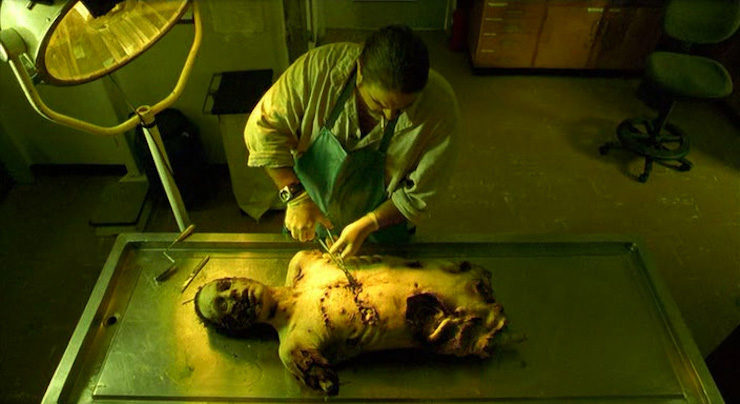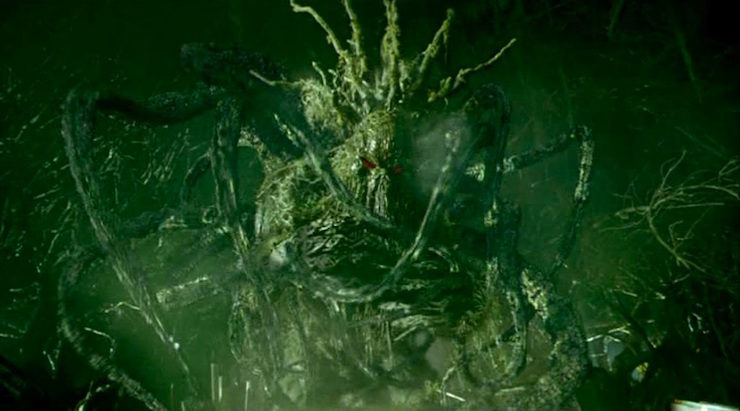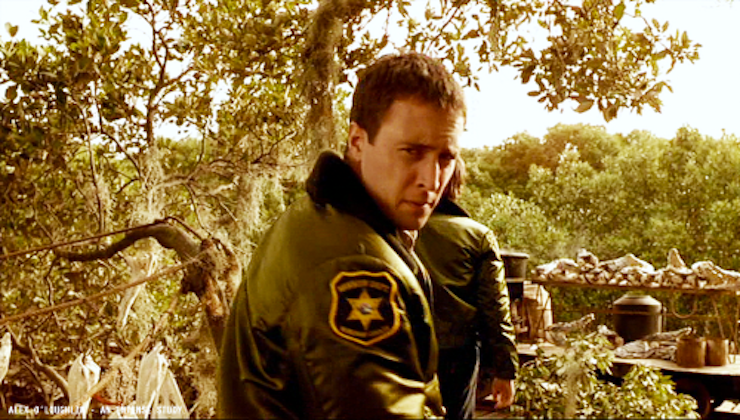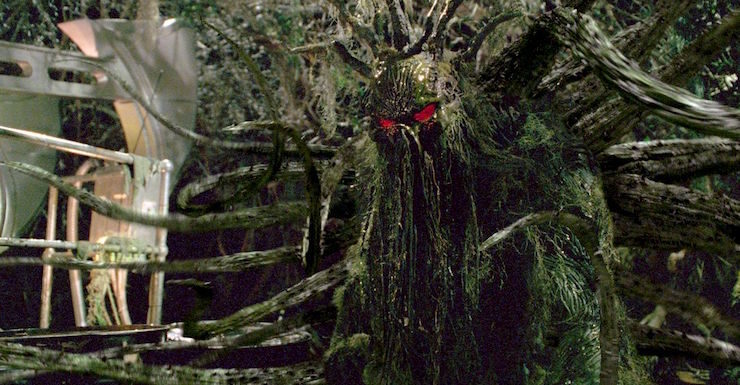First created as part of the horror boom of the 1970s, Man-Thing initially appeared in Savage Tales, a black-and-white horror magazine, which only lasted one issue in 1971. The character eventually became the primary feature of Adventure Into Fear. Created by Roy Thomas and Gerry Conway based on a notion by Stan Lee, eventually Steve Gerber took over the writing chores on Fear, and he created Howard the Duck in one issue.
Dr. Theodore Sallis was transformed into Man-Thing, a silent, barely sentient ambulatory swamp creature. Anyone feeling fear burns when touched by Man-Thing, leading to his infamous tagline (created by Gerber), “Whoever knows fear burns at the Man-Thing’s touch!”
Like Howard, Man-Thing was adapted into a movie. Like Howard the Duck, 2005’s Man-Thing was pretty awful.
Man-Thing eventually got his own book in 1974, written by Gerber, which was cancelled after he left. This was the era of the quarterly “giant-sized” companion comics—as an example, the new X-Men first appeared in Giant-Sized X-Men #1 in 1975—and that included Man-Thing, resulting in the unintended double entendre of a book called Giant-Sized Man-Thing. Amazingly, nobody noticed at the time, though it’s become a running joke in comics in the four decades since.
(There was some concern that Man-Thing and Swamp Thing were a bit too similar—both developed at about the same time, Swampy’s co-creator Len Wein was roommates with Conway, and Wein actually wrote a few of Man-Thing’s earliest adventures, too—but that passed quickly as the two characters evolved in different directions. For starters, Swamp Thing actually could talk…)
Another comics series started up in 1979, written by comics horror master Michael Fleisher and then by Chris Claremont (best known for his historic run on the X-Men comics), with a third in 1998 written by J.M. DeMatteis (who’d written the character in a number of other books).
Mostly, he’s been a supporting character, appearing on and off in various books from Marvel Comics Presents to The Punisher to The Thunderbolts to Dead of Night. Most recently, R.L. Stine wrote a Man-Thing miniseries, the famous author’s first comics work.
Man-Thing was part of a deal Marvel made with Artisan Entertainment in the 1990s to develop several of their superheroes into films. (The Punisher was also part of that deal, and the only other character to actually make it to film, this being the 2004 version with Thomas Jane.) After filming in Australia was completed, the producers kept going back and forth as to whether or not to make it a direct-to-video or theatrical release, with Marvel and Artisan deciding on a theatrical release following the success of the X-Men and Spider-Man films—at least until test audiences saw it and reportedly walked out in the middle. It was quickly removed from its Halloween 2004 release date in theatres and instead was dumped on the Sci-Fi Channel as a movie original in April 2005, then released on home video. Mark Stevens, a seven-foot-tall Australian wrestler and stuntman, plays the title role (we never see Man-Thing as Ted Sallis, only as the creature), and hey look, it’s Hawaii Five-O’s Alex O’Loughlin in a supporting role! Several of the characters in the film are named after creators who worked on Man-Thing in the comics: Steve Gerber, Mike Ploog, Val Mayerik.
“First cup of coffee is on the house; second one costs twice the price”
Man-Thing
Written by Hans Rodionoff
Directed by Brett Leonard
Produced by Avi Arad and Scott Karol and Gimel Evertt and Christopher Petzel
Original release date: April 21, 2005

There’s a new sheriff in Bywater, Florida. Sheriff Kyle Williams arrives in the town—so named because it’s by the water—and meets his deputy, Eric Fraser. The previous sheriff has gone missing, and he was obsessed with solving the unusually high number of missing persons in the region—the most recent of which was a teenager, who was yanked away by something while in the middle of having sex on a canoe—the young woman he was having sex with is catatonic in the hospital.
Williams’s first task is to deal with a sit-in. Schist Petroleum bought up most of the land in the area—which belonged to the Seminoles—and are digging for oil. A local schoolteacher, Teri Richards, is leading the protest, where they’ve all chained themselves to Schist’s equipment. When Williams tries to cut the chain, Richards kicks him, and he falls into the mud. He then arrests her by literally picking her up and bringing her to his truck. However, he doesn’t charge her, and lets her go, believing that her heart is in the right place, and ignoring the fact that she assaulted an officer of the law.
The first person to go missing was the Seminole who brokered the deal with Schist, Ted Sallis. The money Schist paid him is also missing, and while some bodies have been found—some of them with plants growing out of them—Sallis isn’t one of them. (Schist insists that he ran away with the money.) Also, the medical examiner, Mayerik, was told by the previous sheriff to list the cause of death for the bodies they did find as alligator attacks.
In the local diner, Williams meets the Thibadeaux brothers, who put the “dim” in “dimwit redneck asshole”; Horn, a Seminole who warns Williams about bad times ahead; and Ploog, a photographer who’s trying to get shots of whatever is causing everyone to go missing (in the past, he’s gone after the Loch Ness Monster, Bigfoot, and Area 51).
While driving down the road, a dead body falls on Williams’s truck: it’s the previous sheriff (minus a few limbs).

The prime suspect for all this is Renee Laroque, a mestizo who has been sabotaging Schist’s equipment. Williams and Fraser go searching for him, while Schist sends the Thibadeaux brothers after him as well. Whatever it is in the swamp kills the brothers, and also Fraser, while Williams gets stuck in a snare left by Laroque, who insists that he’s not responsible.
With Richards’s help, Williams talks to Horn, who remains inscrutable, because he’s the Native character, and Natives are supposed to be inscrutable. Horn then goes out into the swamp to sacrifice himself to the creature to save the town. His doing so does nothing to save anyone, though we do finally, one hour and thirteen minutes into a one-hour-and-thirty-seven-minute film, get to see the title character as he kills Horn. Man-Thing also kills Schist’s son for good measure.
Williams goes back into the swamp to try to find Laroque, leaving Richards behind at the sheriff’s office, since his deputy is dead. Mayerik calls to reveal that the previous sheriff actually died of a gunshot wound. Richards goes into the swamp and finds Williams (scaring the shit out of him in the process), and not only shares that, but also reveals that she knows where Laroque has been all along.
They arrive to find Schist has already found Laroque, who has placed dynamite on Schist’s rig. Schist admits that he killed Sallis and buried him under that rig. Laroque admits that he was the one who brokered the deal to sell the land, which he now regrets. Williams and Richards arrive and Laroque, Schist, and Williams all contrive to get themselves shot, though none of them fatally. Man-Thing arrives and kills Schist particularly nastily. Laroque blows up the rig. While Williams and Richards dive under the swamp to safety, Laroque himself dies in the blast. Man-Thing is caught in the blast also, but isn’t killed by it. However, the creature does sort of collapse in on itself right after that, and the movie ends with no notion of how the town will survive without Schist Petroleum providing jobs.
“Go fuck a tree!”

I can kind of understand why the test audiences walked out on this. I probably would have, too, except I was watching it in my own house, so where would I go? Also, Tor.com does actually pay me for these rewatches, and man do I feel like I’ve earned it this week.
The biggest problem with this film, before you get to all the other problems (and they’re legion), is that the movie is populated by a whole host of Australian actors doing really terrible Southern accents. Plus a script that writes the characters in the most stereotypical fashion—I’m fairly certain that scripter Hans Rodionoff has never actually heard someone from the South speak, or if he did, he didn’t pay close attention.
The worst offenders, sadly, are the two leads. Matthew Le Nevez, who comes across as a second-rate Michael Shanks, half the time sounds like he’s speaking with an Irish brogue rather than a Southern drawl, and Rachael Taylor is spectacularly inept at hiding her Aussie accent (something she’s much better at a decade later as Trish Walker on Jessica Jones). The two characters also have no chemistry, which mostly derives from their having no personality, so their romance feels tacked-on, tacky, and tactless.
I have to admit that I forgot that Alex O’Loughlin (credited here as Alex O’Lachlan for some reason) is Australian, especially given that he’s spent the past eight years playing the stereotypical all-American Steve McGarrett. His American accent on Hawaii Five-O (and prior to that on Moonlight and The Shield) is way better than his painful drawl as Deputy Fraser in this movie. Having said that, it’s not surprising that O’Loughlin’s career improved from here, as he and director Brett Leonard as Mayerik are the only decent performers in this film. (The moment when Mayerik pauses to smoke a cigarette while talking to Williams is brilliantly played by Leonard.)

But every character in this is a tiresome, idiotic stereotype, from the square-jawed hero to the eccentric weirdo to the compassionate schoolteacher to the slimy-yet-charismatic primary bad guy to the yokel thugs working for the bad guy to the abstruse Native who talks in riddles and mystical warnings. It’s a spectacularly lazy script over a spectacularly boring and predictable plot.
It’s bad enough that this movie is literally a long slog. I mean, seriously, all people do in this movie is slog through the swamps outside Sydney (pretending to be Florida, complete with a fake gator) over and over and over again. And the title character doesn’t show up on screen until the movie’s almost over, and when it does, you’re kind of sorry, because holy shit, the CGI is awful. Remember the line of deteriorating CGI I mentioned two weeks ago, from Spider-Man to Daredevil to Hulk to Catwoman? Well, this movie came out the year after Catwoman, and its CGI is even worse. Just horrendous.
Worst of all, though, is that it reduces Man-Thing to a boring-as-shit scary monster that kills people. The whole point of Man-Thing in the comics is that he’s a tragic figure, a creature who protects the Nexus of Reality that is located in the swamps outside Citrusville, Florida, and who can sense emotions. Sensing fear agitates him, and he secretes a chemical that burns people—hence the classic tagline.
This movie has absolutely none of that. The only thing that’s replicated is the Man-Thing’s look, and that poorly with the worst that early-2000s CGI had to offer. I also have to confess to not recalling a single moment when they established that Man-Thing is actually Ted Sallis. I mean, I assumed it because I know the comics, but I can’t recall if they ever actually mentioned it in the film or not, and the notion of putting the DVD back in to check fills me with sufficient fear that the comics version of Man-Thing would give me third-degree burns.
Next week, we’ll take a look at Marvel’s second attempt to do Marvel’s first family of heroes, as we rewatch 2005’s Fantastic Four.
Keith R.A. DeCandido reminds folks that in addition to his writing for this site, he also writes novels (with the fantasy novels Mermaid Precinct and A Furnace Sealed due out this year), short fiction (most recently “Six Red Dragons” in Baker Street Irregulars: The Game is Afoot), comics (the adaptation of Gregory Wilson’s Icarus, a story in the Eisner-nominated Planned Parenthood benefit graphic novel Mine!), coffee table books (including Orphan Black: Classified Clone Report and The Klingon Art of War), and also bunches of cool stuff on Patreon, including recent reviews of Deadpool 2 and Solo: A Star Wars Story.










